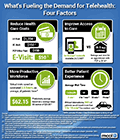
Events by the Alliance
Telemedicine: Ten Things to Know About
Reading Time: 2 minutes
As a self-funded employer concerned by the rising cost of health benefits, what should you know about telemedicine?
The Alliance is bringing answers and consumer engagement experts to its July 16 Alliance Learning Circle to answer that question. In the meantime, here are 10 things you should know about how telemedicine is changing health care.
- It’s “unstoppable.” Many national experts have conceded that telemedicine is here to stay, despite ongoing debates about how it should be licensed and regulated at the state and national level.
- It typically costs less, although savings can vary. Teladoc. External Link. Opens in new window., a leading vendor, says it achieves an average savings of $673 per claim per visit for minor ailments is compared to an in-person visit.
- It’s more than one kind of care. It is a broad term that covers many different types of health care services that are delivered remotely. The ATA. External Link. Opens in new window. describes telemedicine as “the use of medical information exchanged from one site to another via electronic communications to improve a
patient’s clinical health status.” - It’s moving to the workplace. Health care providers are piloting worksite kiosks that enable video chats between the patient and the doctor. Some kiosks are equipped with devices for simple medical tests, such as taking your blood pressure. Kiosks and other telemedicine approaches can be integrated with an existing online clinic or used
to launch onsite care. - A $49 price tag is common for primary care offered directly to consumers. Walgreens and Cleveland Clinic are among the providers that charge $49 for visits.
- When family members can’t be at the bedside of a critically-ill family member, some hospitals now provide updates via telemedicine. Thomas Jefferson University Hospital in Philadelphia uses an iPad, video camera and telehealth software to let family members see and hear doctors as they make “rounds” in the intensive care unit.
- Rural hospitals and skilled nursing facilities use telemedicine to connect patients to doctors without forcing them to travel for specialist care.
- It’s a quick solution for minor ailments. Teladoc says the average wait time to see a doctor is 18.5 days, which compares to Teladoc’s 8-minute average wait time for a primary care telemedicine visit.
- Most people can connect. When broadband Internet access is lacking, patients may be able to connect via cellular phone or satellite signals. But there are some remote areas where connections remain challenging or unavailable.
- It’s growing fast. Telemedicine vendors are partnering with health care systems, national pharmacy chains, employers and other groups to create new options for consumers. Meanwhile, health care professionals continue to find new ways to use telemedicine to improve access to care. Revenue from the U.S. telehealth market is expected to grow from $240 million in 2013 to $1.9 billion by 2018, according to IHS, an information and analytics form. That means this technology is likely coming soon to a computer, tablet or smartphone near you.








